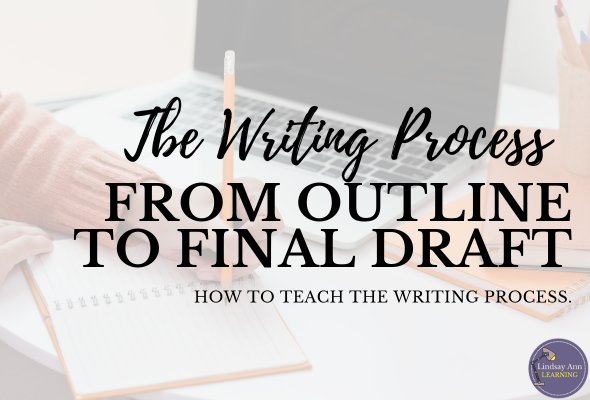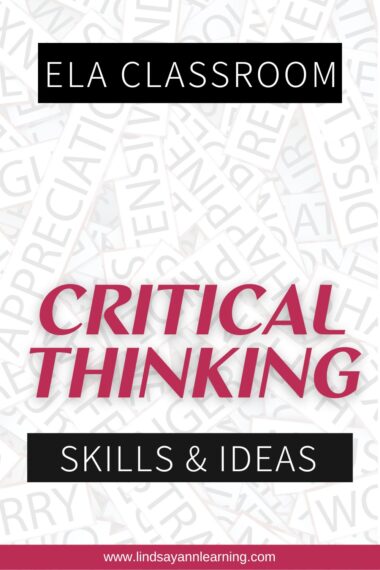Writing is a messy process. Rarely do writers pick up their pen or open a fresh Google Doc and write everything start to finish. To take the genesis of an idea, consider the rhetorical situation, form that idea into whatever genre and format it needs to take, polish it, and then publish it requires a writing process to help make the non-linear process of writing more manageable and productive.

Student writers often struggle with this process. They think one submitted draft means the writing process is complete. The lack of engagement in the writing process can hold a student’s writing in that rough draft limbo land forever.
Empowering students to have agency in their own writing process can inspire amazing writing, increase engagement, and improve students’ metacognition.
Writing Process 5 Steps
The writing process as we know it has 5 distinct stages.
- Prewriting, research & planning: In this stage, the writer is mapping out the writing.
This may include brainstorming ideas, storyboarding the narrative arc, conducting any necessary research and making an outline. Anything that happens before actually writing is considered prewriting.
- Drafting: In the drafting stage, writers are making their first attempt at getting the words on the page. In this stage the writing isn’t expected to be perfect because the writer will eventually go back and make necessary changes. The goal in this stage is simply to get the ideas on paper.
The drafting stage tends to be where student writers think the writing process ends. For many reasons, they lack the understanding that this is a first attempt and will require some finessing.
But writing is definitely not done here.
This looks like reordering sentences, adding sentences, deleting sentences altogether, reordering paragraphs, etc.
In this stage, writers are really ripping their drafts to shreds, taking out what isn’t working and replacing it with more beautiful and functional content in order to better get their message across and accomplish the purpose of their piece.
- Editing & proofreading: During the editing and proofreading phase, writers are carefully combing through the piece to make sure everything is correct. Word choice, sentence structure, rhythm, punctuation, clarity…getting all of it right matters.
Sometimes in this stage it’s helpful to have an extra set of eyes on the draft because it can be difficult for us to always spot errors in our own writing.
- Publishing: Publishing can look very different for every writer. In a classroom, publishing may just mean, I’m finished and I’m going to turn this into my teacher now and she’s going to post it on the class Padlet. It could also mean sharing it with a collaborative writing group or submitting to the school’s literary magazine.
It could also mean pitching the piece to a publication or presenting it to a community group. Basically, in this step, the writer is ready to show off their writing to the world.

Teaching the Writing Process
Students need explicit instruction and time to practice the writing process. Time of course is one of our most precious resources in the classroom, so how can we make the most efficient use of it when teaching the writing process?
Here’s what I’ve found to be particularly helpful:
Use the language of the writing process: Be intentional about using the language of the writing process in your daily agendas, lessons, and feedback. This way when you tell a student something like, “Today you need to focus on prewriting for your upcoming argumentative essay” or “This writing project needs some more revision” or “Do you have your draft completed?” they know what stage of the writing process they’re in and what they need to be doing in that stage of the process.
Teaching writing as a recursive process: The writing process is recursive.
We (and by we I just mean all of us writers out there) can bounce back and forth from the drafting to the revision stage 15 times before moving on. We can also engage in deep and thoughtful prewriting only to abandon the idea before ever drafting because a better one came along and we decided to start prewriting and drafting for that idea.
Breaking students of their bad habits is tough work, but helping students see writing as a recursive process will strengthen their final products and help them gain overall confidence in their writing.
Write daily: Again, I know there are just not enough minutes in the day, but making writing a daily habit is so important.
The writing process doesn’t just have to be used for long-form writing.
If you use a daily quick write, journal prompt, or warmup, have students cycle through the writing process by jotting down a few ideas and making a quick outline before writing, writing, and then revising and editing before turning in or sharing with a shoulder partner.
By being in the habit of writing every day, students will find their groove with their own process for writing and it will become second nature!
Model for students your process: Writing in front of students is Vulnerable (yes, with a capital V). I like writing and even I sometimes get nervous before putting my notebook under the document camera. But I try to make writing in front of my students something I do at least once weekly. I model for them my process, I think aloud what I’m going to write, how I want to write it, and they get to watch me write something, hate it, revise it, and cycle through the writing process.

Status of the class for managing it all: Connor may need three days to organize his ideas in the prewriting stage while Ava only needs about 5 minutes to plan her writing and hit the ground running.
There is no time limit for being in a particular stage of the writing process (unless ya know, they’ve got their phone propped up behind their Chromebook watching Euphoria instead of writing, then we’ve got problems. But I digress…).
Despite that knee jerk reaction to herd our students like cattle through the writing process, it needs to be differentiated for each writer in the room.
So how the heck do you manage that?
Utilizing a status of the class for the writing process helps you keep track of where each writer in the room is and can also help you better plan small group or individual instruction and coaching.
If you just do a quick Google search for the status of the class in the writing workshop, you’ll see approximately one million great ways to do it, but I particularly like the visual Stacy Shubitz at Two Writing Teachers created for her classroom.
Ideas for Brainstorming and Initiation

Check out these ideas to get students engaged in the writing process and shorten the time they stare at a blank page:
- Storyboarding: Draw out problems and solutions and organize them in a logical order.
- Alphabet boxes: See if you can come up with one idea for each letter of the alphabet.
- Heart Maps: Can be used for all writing genres!
- Keeping a writer’s notebook: Have all of your brilliant ideas living in one place. When a new one comes along, jot it down in the notebook!
- Pomodoro technique: Set a timer for 25 minutes and write. When the timer goes off, take a 5 minute break, reset the timer for 25 minutes, and continue writing.
- Stream of consciousness: Write whatever comes to mind about your spark of an idea for writing. When you’ve written all you have to say, use a reverse outline to organize your ideas and continue drafting or begin revising.
Writing Process Stages

Break assignment up for students: Depending on your students’ skill levels, they may need you to break the assignment up into the stages of the writing process and assign one stage at a time.
Design cycle for STEM and PBL: The writing process is similar to the design cycle used for STEM and PBL ( yes, even engineers need to understand the writing process!).
Have students create their own goals and workflow calendar: In her book Project Based Writing, Liz Prather shares how she has students establish goals for their writing as part of the prewriting process as well as develop their own calendars using a reverse engineering process.
For example, if a student has 25 days and intends to create a poem about the changing seasons, they will need to break down the project into individual tasks and then map out on their calendar how many days they will need for each task.
Wouldn’t it be amazing if by the end of the year students could move 100% autonomously through the writing process?!
Writing Process Revising v. Editing
What is the difference between revising and editing in the writing process?
Revising focuses on content only. When you are revising your draft you may notice you are missing a comma or misspelled a word. That’s great! But in the revising stage, those observations don’t matter. Instead, you’re only focusing on making your mystery narrative more suspenseful or making your satirical article more humorous.
You address those spelling, grammar, and mechanics errors in the editing stage.
Oftentimes in the classroom, the editing phase of the writing process is merely relegated to peer editing, which usually looks like a student’s paper getting shipped off to another student and being told to magically edit it without any guidance.
Peer editing often gets a bad rap, but I have found that peer editing does have some redeeming qualities if explicitly taught and done correctly.
Other Misconceptions
Sometimes misconceptions about the writing process hold us back from being our best possible teacher selves and hold our writers back from being their best possible writing selves. So as we wrap up, let’s debunk some of these common misconceptions.
- Only writers who have problems in their writing need feedback: Ummmmm noooo.
Even Jodi Piccoult has a literary agent and a team of editors at her publishing house to make sure her writing is perfect before being published. If it’s good enough for the New York Times bestselling author, it’s good enough for all of us. - Every piece of writing needs to go through the full cycle: While it would be totally ideal to take every possible idea we ever have for a writing project and then brainstorm it, research it, outline it, draft, revise, edit, and then hit publish, that’s not really realistic.
It’s okay to give up on a piece, change your mind on your idea, or have 6 drafts before it’s ready to be edited! - You need to use the same process each time: The writing process is intended to be flexible.
Now listen, I fully believe students have to learn the rules of writing (writing process included!) before they can learn to break them. But each student’s process doesn’t have to be the same.
If someone in your classroom needs to fully brainstorm each writing assignment using a storyboard before writing and you have another who needs to write a stream of consciousness before getting organized, it’s all good!
Allow students to find their own way in the writing process. That’s where the really good, authentic writing lives!















 What Are Authentic Assessments?
What Are Authentic Assessments?